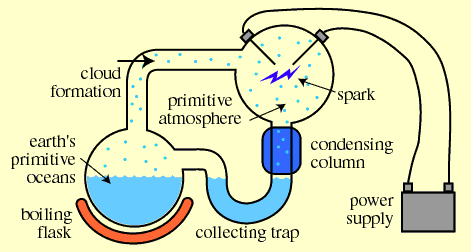
Researchers from France and the Czech Republic put a spin on a seminal science experiment that recreates the conditions necessary for life to appear. They mimicked Earth’s early atmosphere as it was impacted by cosmic bodies like meteorites and found the interaction produced all the four based of RNA, which is chemically related to DNA and just as essential to life. The findings support the RNA World and the Origins of Life hypothesis, according to which RNA stored both genetic information and catalyzed the chemical reactions in primitive cells.
Back in the 1950s, two biochemists named Stanley Miller and Harold Urey sealed a mixture of gases that modeled Earth’s early atmosphere as scientists assumed it must have been like at the time, then zapped electricity through the brew. The experiment showed that several organic compounds could be formed spontaneously this way from inorganic compounds, including amino acids — which are the building blocks of proteins.
The Miller-Urey experiment was a total hit and the findings traveled the global instantly, as it was the first study to add some tangible evidence to the theory that life first appeared spontaneously.

As years past, however, the Miller-Urey experiment passed out of favor among scholars, though to this day it’s one of the most widely enacted experiments in high schools and universities around the world. Fred Hoyle, an astrophysicist, once compared the likelihood of life appearing on Earth by chemical reactions “as equivalent to the possibility that a tornado sweeping through a junkyard might assemble a Boeing 747 from the materials therein”. Critics have argued that even though amino acids can provide the necessary primitive biochemistry for proteins to form, you need more than just proteins to activate a cell’s catalytic chemistry. Miller and Urey couldn’t have known at the time, but both RNA and DNA seem to be heavily involved in biochemistry.
Another problem with the Miller-Urey experiment was that it assumed Earth’s early atmosphere was ‘reducing’, the opposite of today’s ‘oxidizing’ one. Since then, researchers now largely presume our planet’s early atmosphere was neutral, somewhere in between reducing and oxidizing.
But this textbook experiment isn’t done yet. Researchers gave a new spin on the experiment to add something Miller and Urey hadn’t originally considered: impacts from cosmic bodies, an extremely common occurrence on primordial Earth.
In the new study, the researchers argued that Earth’s atmosphere from 3.6 billion years ago was a bit on the reducing side, which is somewhat different from the atmosphere used by Millet-Urey but still relevant. The aim of the study was to monitor the gases for formamide, a compound made of carbon, nitrogen, and oxygen, with hydrogen in between. Previously, research showed that under the right conditions, formamide can react with itself to produce all the four RNA bases.
To mimic the shockwaves produced by an extraterrestrial impact, the researchers turned to the Prague Asterix Laser System which can generate Terawatt-sized pulses. The shock waves caused chemical reactions that went on to form formamide and, eventually, all the four RNA bases, albeit in minute quantities — barely above the detectable limit, but that’s Ok since a real impact would have been much more powerful.
“We show that RNA nucleobases are synthesized in these experiments, strongly supporting the possibility of the emergence of biologically relevant molecules in a reducing atmosphere. The reconstructed synthetic pathways indicate that small radicals and formamide play a crucial role, in agreement with a number of recent experimental and theoretical results,” the team wrote.
The findings published in PNAS support the RNA World theory, which posits bacterial cells cannot form from nonliving chemicals in one step. Instead, there must be intermediate forms, “precellular life,” and RNA is the leading contender because it has the ability to act both as an enzyme and encode genes. This offers a way around the “chicken-and-egg” problem (Genes require enzymes; enzymes require genes). While the sort of atmosphere assumed by the study is debatable, it’s exciting to hear about a plausible route for producing the basic building blocks of RNA and life eventually.
[via ArsTechnica]


